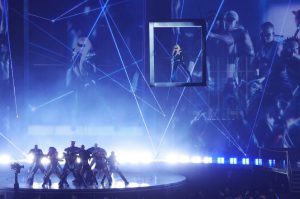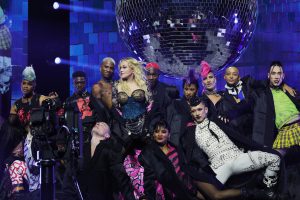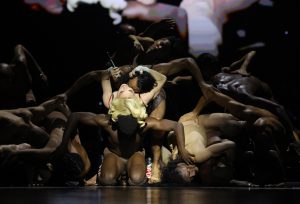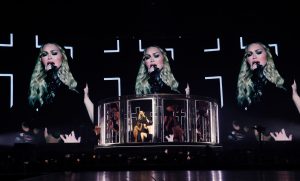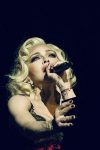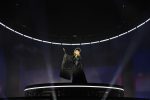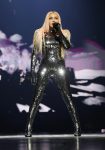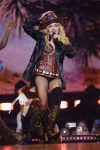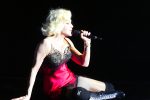REVIEW: Madonna tells a compelling story at second Chase Center show
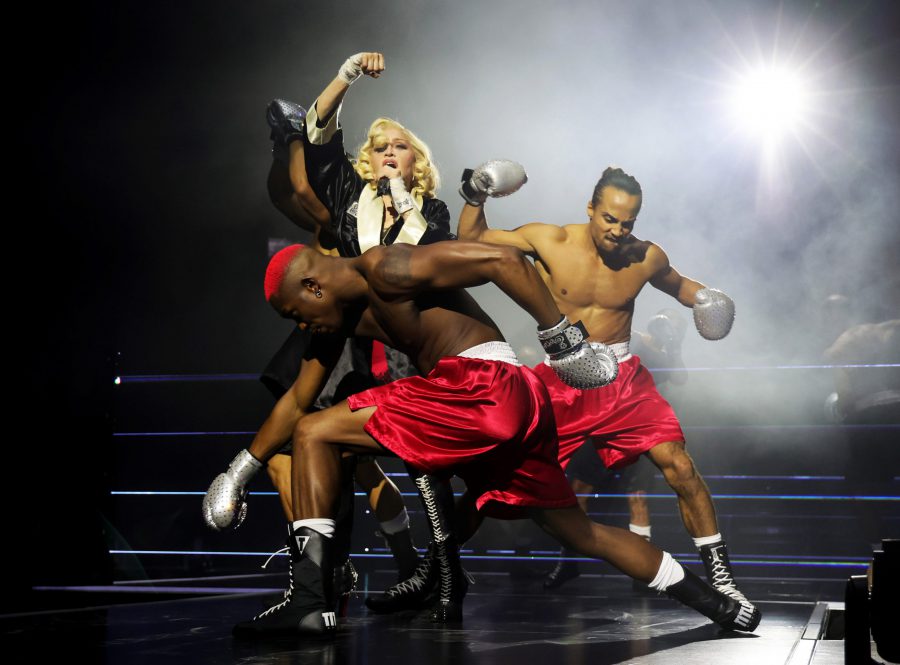
Madonna performs at The O2 Arena in London on Oct. 14, 2023. Photo by Kevin Mazur/Live Nation.
SAN FRANCISCO — The people who increasingly hate on Madonna about her seeming fixation on the passage of time and mortality, her looks after plastic surgery or her open sexuality—yes, at age 65—are the first ones to note that she doesn’t move like she used to in her 20s. Or they compare to her to much younger acts who’ve taken up the mantle the Queen of Pop once carried. Maybe she’s not the one who refuses to accept her age. Maybe it’s them.
At the second of two Chase Center shows on her Celebration Tour, showcasing her four decades in the music business and her story in her own words, Madonna performed admirably in a way that highlighted her vocals, her envelope-pushing accomplishments and, on a handful of songs where live, acoustic instrumentation was employed, her songcraft.
Sure, she performed with a leg brace, and an entire squad of talented dancers had top billing on the choreography, but that seemed to show Madonna knows who she is at this point in her life.
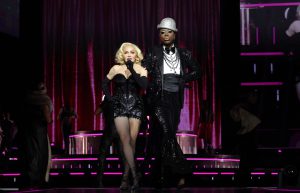
Madonna and and Bob the Drag Queen perform at The O2 Arena in London on Oct. 15, 2023. Photo by Kevin Mazur/Live Nation.
The Celebration Tour is Madonna’s first that isn’t propelled by a new album. It arrived in the Bay Area roughly six months later than expected following a medical emergency attributed to a bacterial infection. She was reportedly in a medically induced coma for several days. Due to the rescheduling, one of three originally scheduled shows was canceled.
Madonna has such a long songbook of hits that to cover material from all 14 of her albums—which she did—some of the biggest ones like “Papa Don’t Preach” were either left out or squeezed into recorded interludes between the seven acts of the show. Others like “Human Nature” and “La Isla Bonita” were shortened to fit the runtime.
The star is well acquainted with concept performance (one needs to look only as far back as 2019’s Madame X shows). The Celebration Tour, too, is theatrical in nature. Starting with a story of Madonna leaving Michigan for New York City in 1978, it traversed the ’80s, ’90s and the aughts. It was like one of those Broadway-ready biographies but starring the actual subject and a lot more risqué.
And that’s another thing; while some have labeled this tour as difficult to follow, I thought the through line connected her narrative well. The songs didn’t always follow a chronological order. She opened with “Nothing Really Matters” from 1998’s Ray of Light, clad in a black dress and LED halo atop her head, with the stage rigging above her head acting as a second lit halo. But they always fit the aesthetic of the part of her life she was singing about. The tour’s emcee, Bob the Drag Queen, provided narration at a few points to keep the story moving.
Production-wise, Madonna is still at the top of her game. Starting on a small round “main” stage that at times would rotate, Madonna and her dancers and musicians spent much of the show on the maze of catwalks that crisscrossed a good chunk of the arena floor. At time, she or a musician would be lifted 30 or 40 feet up in a box that would take her from one end of the room to another.
Following an energetic “Everybody,” performed against the New York skyline, she hit the show’s first peak with “Into the Groove.”
“I still got it!” she declared afterward. “I wanna leave a part of my flesh on this stage.”
A song later, she stopped to chat to the crowd about realizing what self-love is.
“I love all of me. All my bad hairstyles. All my bad husband choices,” she said, before picking up a black Gibson electric guitar for the punky “Burning Up,” strumming along to the backing track. It was a bold, questionable move to sing to backing tracks for most of the night (the production on most of the songs was tweaked to make the songs sound fresher). But during the songs when a musician would appear on stage—a guitar here, a cello there, Madonna’s daughter Mercy James on piano for “Bad Girl”—it brought poignant attention to the musical performances.
She and her dance team concluded the first act with “Open Your Heart” and “Holiday.” The former included a steamy chair routine, while the latter was set in a club to which the star had problems getting in. Her dancers encircled her on the spinning main stage.
The second act was shorter but hit harder. After a moving “Live to Tell,” during which Madonna floated in her box past images of lives claimed by the AIDS epidemic—both famous and ordinary—a large contraption appeared on stage that resembled a gigantic jewelry box or a carousel enclosure. The entire contraption, full of dancers, spun around as Madonna sang “Like A Prayer,” moving from one of its openings to another but not being able to get out.
The third act offered more surprises; this time, several boxing rings popped up on connected catwalks. The dancers were dressed like boxers, but due to their choreography looked more like video game non-playing characters for “Erotica.” By this point, Madonna herself had undergone numerous costume changes (and she would have numerous more), but the changes happened so quickly that it didn’t slow the show.
This song and several others included risqué segments (simulated masturbation isn’t that shocking anymore; even The 1975’s Matty Healy has been doing it at shows), but the topless dancers of all genders during “Hung Up” (which is still a great rager) were enough to raise eyebrows of those not expecting it.
That’s when Madonna’s daughter Mercy James appeared behind the keys of a grand piano to perform a beautiful rendition of Charles Mayer’s “Le Regret op. 332,” a piece of classical music, and then “Bad Girl.” The otherwise stoic pianist flashed a smile as mom sang, “You will always be my baby” before climbing on top of the piano.
The concert’s most euphoric highlight, “Vogue,” included done-up dancers—even Madonna’s daughter Estere—walking the runway with Madonna and drag queen Trinity Taylor scoring them. Daughter Stella was also in the mix, dancing, and son David played guitar on “La Isla Bonita” and “Don’t Tell Me,” during which she and her dancers mimicked the dance moves from the song’s music video.
“Now we’re in the 2000s. This is where motherhood comes in, and I realize I’m not the center of the universe,” she said at one point.
Madonna herself played an acoustic guitar during a touching rendition of “Express Yourself,” backed by a cellist and thousands of people singing along with her.
There was also a possible goof—she thanked “Sacramento” (though perhaps it was purposeful because she reportedly said the same thing at Tuesday’s show), before telling a lengthy story of going on a road trip to San Francisco in the ’70s with her family. She said she was dreading the trip because she was 16 and wanted tampons, but her stepmother said tampons were “like having intercourse.” She hoarded them in her sleeping bag nonetheless (they slept in a tent they would pitch every night). When the family arrived at Lake Mead in Nevada, the tampons came flying out, and she was essentially grounded for the rest of the trip, missing out on everything other than what she saw from the family’s van.
“People were walking around barefoot, women were in bras and flowers in their hair,” she said. “San Francisco looked like heaven to me. Everybody looked free.”
Somehow, the conversation quickly pivoted to war in the Middle East. Madonna made it clear she’s not picking sides, other than: “I am on the side of love. I want everybody to be free.”
The show continued on in this way, mixing joy and sexual tension from song to song, past “Don’t Cry for Me Argentina,” “Bedtime Story” and a techno remix of “Ray of Light.” If I had to find something to pick on, it would be that separating Madonna from her dancers muted the euphoria-inducing effects of the latter song.
Then following the emotional “Take a Bow,” Madonna pivoted again to a video tribute to Michael Jackson. It was upbeat, if not poorly timed (but, hey, it’s in there because it must be important in her telling of her story). That set up the night’s big closer, “Bitch I’m Madonna,” during which many of the dancers appeared as older versions of Madonna herself for one big dance sendoff.
- Madonna performs on The Celebration Tour. Courtesy Ricardo Gomes.
- Madonna performs at The O2 Arena in London on Oct. 14, 2023. Photo by Kevin Mazur/Live Nation.
- Madonna performs at The O2 Arena in London on Oct. 14, 2023. Photo by Kevin Mazur/Live Nation.
- Madonna performs at The O2 Arena in London on Oct. 15, 2023. Photo by Kevin Mazur/Live Nation.
- Madonna performs at The O2 Arena in London on Oct. 15, 2023. Photo by Kevin Mazur/Live Nation.
- Madonna performs at Chase Center in San Francisco on Feb. 28, 2024. Roman Gokhman/STAFF.
Follow editor Roman Gokhman at Twitter.com/RomiTheWriter.

